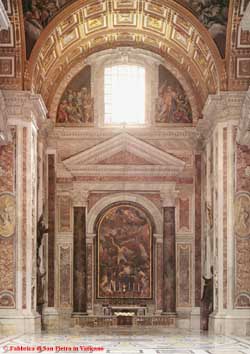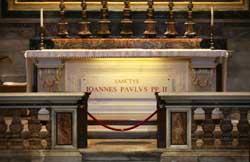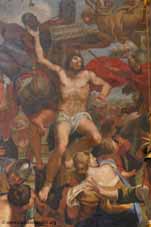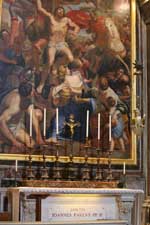|
On June 2, 1672, the remains of Sts Innocent, Victor, Candidus and
Laureatus were placed in the altar. Originally, the
altarpiece was supposed to feature a painting portraying the life of St.
Peter. Domenichino, the artist employed by the Congregation, was
instructed to paint a picture of an episode of Peter's life.
Domenichino came from the city of Bologna and was of the Bolognese
School, a group of artists that also included Lanfranco and Ludovico
Carracci. The topic originally chosen was taken from the book of Acts,
in which Peter converts a Gentile to Christianity, one of the first
such conversions. However, two groups had say over the decoration of the
altar: The Congregation and the Chapter. The Congregation of the
Fabricca of St. Peters, a group of cardinals and high-ranking
churchmen, oversaw the construction of the new basilica. The Chapter
of St. Peters were the group of priests who performed the sacraments and
said mass in the basilica. The Chapter eventually proposed artwork
illustrating the martyrdom of St Sebastian, believing that he was
important enough to warrant a major chapel. The altar of St. Sebastian
was painted by Domenichino between his commission in 1625 and 1631, when he
left Rome for Naples. Domenichino's work took place under Pope Urban VIII, who
reigned from 1623-44. Pope Urban VIII and his family, the Barberini,
were known to have a personal connection to St. Sebastian, having
patronized all three sites in Rome associated with him. In fact, the
Barberini family chapel was built on the site where St. Sebastian's body
was dragged from the Cloaca Maxima.
The painting
represents St. Sebastian's martyrdom under the Roman Emperor Diocletian,
usually dated in the year 288. Sebastian was a member of the
Praetorian Guard, and fell victim to the emperor's persecution of
Christians. Diocletian's was the largest persecution of Christians in the Roman period, and also the last before Constantine's adoption of
Christianity. Sebastian fell victim to the persecution twice; the
first time he was shot with arrows, but nursed back to health by St.
Irene. After this, he criticized Diocletian to his face, condemning him
for his treatment of Christians. For his efforts, he was beaten and
thrown into the Roman sewer, the Cloaca Maxima. It should be noted
that Domenichino was a painter and not a historian, as his painting
combines elements of both events.
St. Sebastian was
known as a plague saint, thought to have the power to ward off disease.
According to legend, the erection of an altar in his name was enough
to ward off a plague that ravaged Italy in the seventh century. As the
Renaissance period was rife with plagues which often devastated whole
communities, he was quite popular among Christians of that time.
Specifically, in the 1620s, Rome lived in fear of a plague that was
spreading throughout the Italian Peninsula. 10,000 people died in
Florence alone, and veneration of St. Sebastian was sought in order to
protect the Eternal City.
Sebastian was a
popular subject among Renaissance painters, as many artists of that
period, from Botticelli to Titian to Perugino, all painted him in some
form. Sebastian's image in the painting, from the sign above his head
to the full beard he sports, show a conscious effort by Domenichino to
make the martyred saint look like the popular image of Jesus. As martyrs
were thought to be emulating Jesus, Domenichino sought to mould
Sebastian in his image.
In its day, the
painting recieved much criticism, both from the public and from
Domenichino himself. Many thought that the painting was too crowded,
and Domenichino wrote that he hoped for a chance to re-do the
painting, even to the point where he hoped the altar would fall into
disrepair. Domenichino worked on the painting until 1631, when he left
Rome in a hurry for Naples. There, the Neapolitans commissioned him to
decorate the Naples Cathedral. Perhaps because of this, he recieved
only 800 scudi (this being the currency of the papal states), and for
the rest of his life he felt that he was underpaid. He claimed he ought to
have recieved 1500 scudi, nearly twice what he was paid. For
comparison, sculptors carving statues on the collonades were paid 80
scudi per statue. On the other end, Pietro de Cortuna recieved 5200
scudi for his work on the cartoons he created for the vestibule mosaics (he
also felt that he was underpaid). Domenichino died in 1641, allegedly
at the jealous hands of a group of painters known as the Cabal of
Naples. This group was a triumvirate of painters who sought to eliminate
competition from other artists. His dispute over payment did not end
with his death, however, as his heirs continued to harass the
Congregation for back payment.
In the cupola,
above the vestibule and before the chapel, are mosaics featuring stories
and legendary figures of the Old Testament, from Abel to Daniel. These
were based on cartoons drawn by Pietro de Cortuna between 1652 and
1662. The mosaics depict a theme of martyrdom, where God in Heaven is
worshipped by the martyrs. The cartoons on the lunettes were drawn by
Raffaele Vanni between 1658 and 1663, and transferred onto mosaic by
matteo piccioni. The mosaics on the spandrels represent Abel, Isaiah,
Zechariah, and Ezekiel. Abel and Isaiah are the work of Guidubaldo
Abbatini in 1656, while Zechariah and Ezekiel are the work of Bartolomeo
Colombo, who made these between 1661 and 1662. Fabio Christofari
constantly worked to maintain these mosaics, which were frequently
detached as the linseed oil used to attach the stucco dripped to the
floor due to the hot Roman summers.
More than a century
after Domenichino, Pietro Paolo Christofari copied his St. Sebastian
altarpiece onto a mosaic between 1730 and 1736. Like his father, Fabio,
Pietro was a prominent Baroque painter and decorated many of the domes
and altars that now adorn St. Peter's Basilica. His mosaic was modeled
on a cartoon by the artist Giovanni Domenico Campiglia, made between
1725 and 1726. In 1730, Domenichino's original work, done on stucco, was
relocated to the church of Santa Maria degli Angeli by Zabaglia.
Zabaglia was a sampietrino, a skilled worker involved in the
maintenance of St. Peters. He was also a famous inventor who specialized
in transporting and preserving works of art.
On the right side
of the chapel, there is a statue of Pius XI (1922-1939), the first head of
state of Vatican City, after its creation in 1929 due to the Lateran
Pact with Italy. This statue was made by the artist Francesco Nagni in
1949. On the left side, at the behest of the cardinals he created, there is a
statue of Pope Pius XII, who reigned from 1939-1958 and
oversaw the Second World War and the fall of Fascism. His statue was
carved by Francesco Messina in 1964.
by Sam A Howard
Sources
The
Altars and Altarpieces of New St. Peters, by Louise Rice
Saint Peter in
the Vatican: The Mosaics and In the Sacred Space, ed. by Jaca Book, SpA
The Mosaics of Saint Peter's Decorating the New Basilica, F. R. DiFederico
The Oxford History of the Popes, by JND Kelly
|




|

